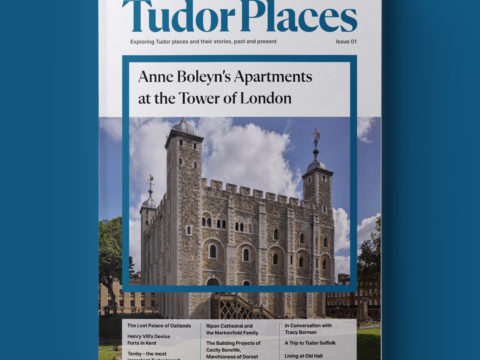Lost Palace of Whitehall (Review)
Historic Royal Palace's New Visitor Experience
On Wednesday, 28th July 2016, we were fortunate enough to have places on the 6:30pm tour of Whitehall Palace. This is a new tour which is being trialled by Historic Royal Palaces and I’m bound to say it was one of most unusual and innovative tours that I’ve ever taken. The aim is to recreate in the visitor’s mind’s eye the great Palace of Whitehall, in which ambition it succeeds admirably – at least in the case of the two representatives of Tudor Times who took the tour.
Whitehall was developed by Henry VIII out of the old York Place, the London home of the Archbishops of York, which he confiscated from Cardinal Wolsey in 1529. He then set about renovating it to create a new and modern royal residence to replace, or at least augment, the rather ramshackle mediaeval Palace of Westminster.
Sadly, Whitehall Palace burned to the ground in 1698, leaving only the stone Banqueting House, designed by Inigo Jones, which had been added by King James VI & I in 1622 and the Holbein Gate. The Tudor palace, which was largely built of timber and brick, was annihilated.
The tour begins in the entrance to the Banqueting House on the east side of Whitehall, more or less opposite the entrance to Downing Street. Registration takes place in the under-croft where there are W.Cs, but no cloakroom, so be careful not to take too much to carry, as you will need at least one hand fully free for carrying the audio guide. As much of the tour takes place outside, don’t forget your umbrella, and I would recommend flat shoes too.
After registration, you are handed a set of very high quality headphones, and an audio guide, the like of which I have never seen before. I will not describe it as that may spoil the surprise. After a brief introduction on how to use it, you are then guided to a woodblock representation of the palace in plan form.
The audio guide begins at this point and it is extremely well done. After a brief history of Whitehall, you are led outside and the tour follows the boundaries of what was once the largest palace in Europe, not even rivalled by Versailles. The old footprint of the palace stretches all the way from Whitehall, along Horse Guards Avenue and past the Ministry of Defence building, to the Embankment.
En route, the tour stops more or less over the location of Wolsey’s wine cellar to hear more about the palace of the 1520s. During the 16th and 17th centuries the Thames was not embanked and was therefore much broader, lapping right up to where the Ministry now stands. Another small relic of the original building can be seen here, Queen Mary’s Stairs, the stone staircase built for Mary II to allow her to enter her royal barge.
After receiving more information the tour then continues around the Ministry of Defence to emerge once again in modern Whitehall at the location of the old Privy Gardens. Across the road, the tour again stops where the old Holbein Gateway once stood. This beautiful construction, with the terracotta roundels, similar to those at Hampton Court survived the 1698 fire, only to be dismantled in 1759. It was probably in the upper stories of the Holbein gate that Henry VIII and Anne Boleyn were secretly married on 25 January 1533.
One of the most historic events to take place at the palace, was the execution of King Charles I on 30th January 1649, immediately outside the Banqueting House, following a last few hours in his chamber inside.
The tour re-enters the Banqueting House and climbs the sweeping stone staircase up to the main banqueting hall, which saw many of the great masques of the reigns of James VI & I and then of Charles I and Henrietta Maria. At the end of the hall is a red velvet throne: rather amusingly there is little sign on it requesting visitors to refrain from sitting on it. I’m not sure if there is a handy headsman to deal with anyone guilty of such an act of lèse majesté, but I didn’t wish to chance it.
Above is one of the greatest artistic gems of the 17th century, the ceiling painted by Peter Paul Rubens at the instance of Charles I, to commemorate his father. Following its installation, masques were discontinued in the Banqueting House less the smoke from the candles damage the painting. The video in the hall gives more details about the palace.
One of the most interesting aspects of the tour was the way that different elements of the palace’s history were brought to life, rather than it being a chronological account. We heard about the 1520s and 1530s, the early 1600s, the 1620s, the Civil War and the Restoration.
This is a truly original and immersive experience and is highly recommended. We understand that there are separate audio guides for adults and children. From our experience of the adult tour, we are very confident that the children’s tour will be equally fascinating.
The experience runs until 4th September 2016, with daytime tours (suitable for children 7+ years) and evening tours (for age 16+ only). Highly recommended.










